
than any other feature on the saw. By using the medallion,
you can estimate the age of your saw.
This article was first published in 2001, and revised countless times through 2007. Some of it should be considered flawed interpretation of data, reflecting what was the best that could be done at the time. For the most accurate timeline of Disston saw medallions, consult the second edition of this article.

|
The medallions on Disston handsaws changed more over time than any other feature on the saw. By using the medallion, you can estimate the age of your saw. |
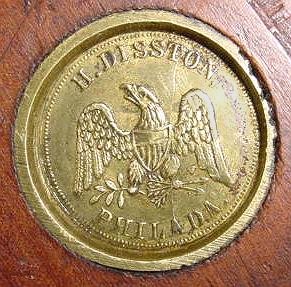
|
This medallion from a handsaw is different from those above and below it in that it is from a full-sized saw. It measures approximately one inch in diameter. Its detail is remarkable and the condition is the best that is to be found. | |
 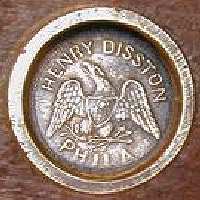
|
The left medallion, from an 1840's No. 7 panel saw, reads "H. Disston. Philada". It may not be the earliest example of a Disston medallion, but it's close to it. It appears identical to the medallion at the top of the page, which is on a backsaw from the same period. Note the eagle's head is pointed upward. Medallions after the 1840's had less "optimistic" eagles. The right medallion started appearing in 1845. | |
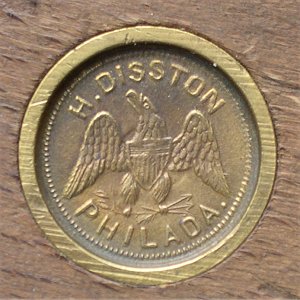
|
A nice medallion. It fits somewhere in the 1840's era. The abbreviation of Philadelphia changes several times on the early medallions. | |
| Above is an early medallion from a backsaw, possibly late 1840's, based on the full spelling of Henry Disston. A similar medallion, below, includes the phrase Keystone Works, which started appearing in Disston sales literature about 1850. Any of the saws with medallions from the 1840's are "rare birds". Consider that Disston started out making only several hundred saws annually in the first years of production, increasing to perhaps 10 or 14 thousand saws per year by the end of the first decade of production. That figure is interpolation based on the statement in advertising that "dozens" of saws were made each day in the factory by 1850. | ||
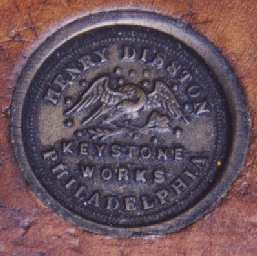 | ||
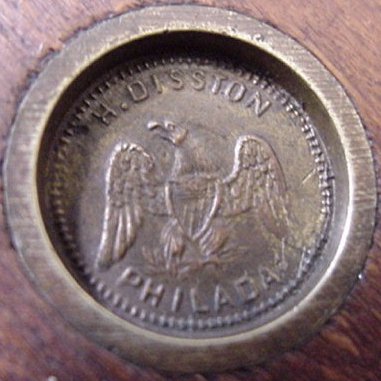 |
A medallion from the 1840's or 50's era, with lettering different from the others, but a eagle design similar to some of those shown below. At least some of these several designs must have been used into the 1850's. | |
 |
Another medallion from a backsaw, probably from the 1840's. The eagle is the same design as the one below it, except it is the mirror image. Stars appear on either side of the eagle. The lettering has serifs, like the earliest medallions, and the city is abbreviated "Philada" as well. Shown also is the same design, approximately 1" in diameter, found on a full-sized handsaw.
| |
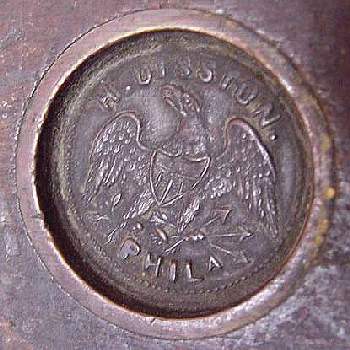 |
1840's medallion with "H. Disston. Phila" in the stamp. Note the small size of the letter "A". There are several variations found in these early medallions, and it is difficult to put them in precise temporal order. However they generally can be narrowed down to their decade of manufacture. The earliest medallions have the most crisp detail in the eagles. Some from the late 1840's are downright crude, like the two below. | |


|
Medallions from either the late 1840's or 1850's. I don't have information to further pinpoint the date. They appear to be identical. | |
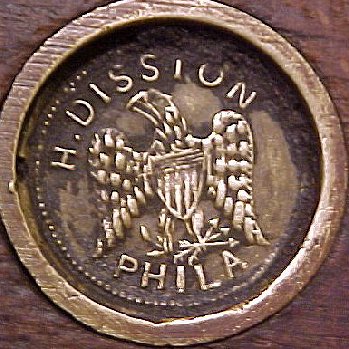
|
Another medallion from either the late 1840's or 1850's. The design looks more like the 1850's and 1860's medallions than the preceding ones, but it uses the PHILA abbreviation. The eagle is becoming more stylized when compared to the realistic eagle design of the early 1840's. | |
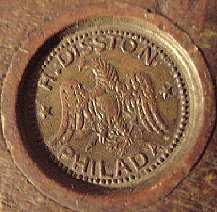 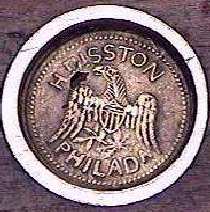
|
Eagle medallions, 1850's. Left has two stars, right does not. Compare alignment of letter "N" of Disston in relation to the eagle's "shoulder" on the two medallions. This rule of thumb may put the collector's value of these saws into perspective: A Disston saw with the eagle medallion was made during Abe Lincoln's lifetime, so it is collectable and should not be over-cleaned or used to cut wood. There are millions of late 19th and early to mid-20th century saws available to be used. | |

|
1850's, differs from medallions above. Note the shield on the eagle's breast; not all the difference can be attributed to wear of the brass. One more note about eagle medallions: Don't confuse the very common Warranted Superior medallion -- made for over 100 years featuring an eagle -- with the medallions on early Disston brand saws. See below |
|
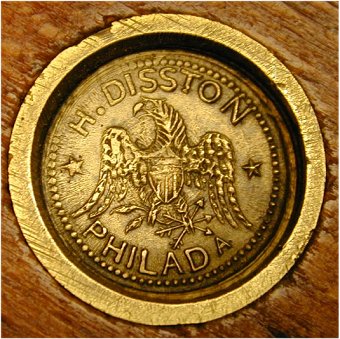
|
1860's medallion used until the "one-son" medallion started to appear in 1865. The only significant difference between this and the earlier medallion is the "pimples". Dots appear at the end of the words Disston and "Philada" on the medallion below. The differences between the 1850's and 1860's eagle medallions are small and probably not reliable for narrowing the date of the saw to one decade or the other.
|
|
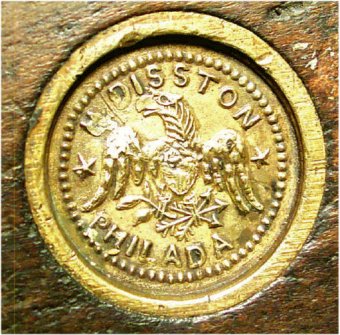
|
1860's. Yet another variation in the early medallions. The appearance of different wings show that another die was used to make this medallion. Notice also that the pattern of dots on the perimeter is courser than the medallion above it. The Mona Lisa smile can be attributed to something marring the brass. Feel like an expert if you can narrow the age of a saw to within a decade in the field. |
|
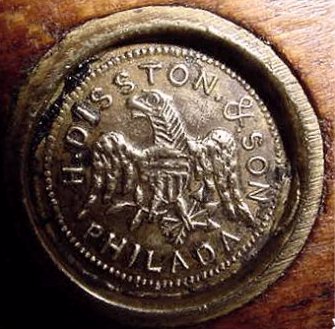
|
1865-71 One-son medallion. Split sawnuts. The company changed its name to Disston and Son in 1865, when Henry Disston's eldest son Hamilton joined the business. He had apprenticed at the company in the late 1850's and early 1860's. During the Civil War he joined the Union Army against his father's wishes. Henry Disston relented and eventually encouraged other workers to volunteer. "Ham" Disston's war experience, volunteer work in the fire department, and hands-on work in the factory made him popular with the other employees. This particular medallion is rarely seen, and was produced for only a short time before the keystone medallion was introduced. Often saws from the mid to late 1860's feature a Disston and Son etch on the blade and the earlier eagle medallion. That feature predates the introduction of the "one-son" medallion. |
|
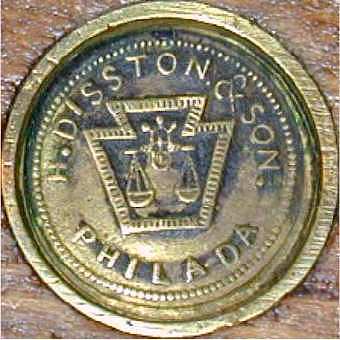
|
One son medallion, 1865-71. This is found more frequently than the previous medallion. The saws have split nuts. When Albert Disston completed his apprenticeship at the factory in 1871, the company became Disston and Sons. Three younger brothers: Horace, William, and Jacob, eventually worked for the company as well. |
|

|
The company changed its name to Disston and Sons in 1871. This medallion still featured the old-style split sawnuts that were used until about 1876. The perimeter is also sanded flush with the surface of the handle, as were all previous medallions. This changed with the introduction of the new-style saw nuts in the mid-1870's. | |
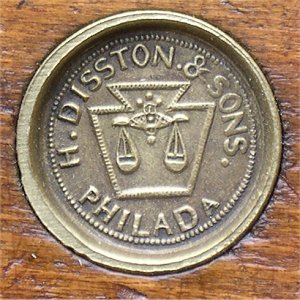
|
This medallion, the one before, and the next, are all variations on the same design and time frame, the 1871-74 period. The three could be in any order, your choice; this happens to be mine. This medallion has a dot at the end of the word "SONS". | |
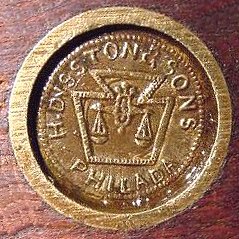
|
As you can see, there were several medallion designs in the 1871-76 era, with subtle differences in appearance. This and later medallions also have a larger letter "A" at the end of word "Philad'a" than on earlier saws. I don't presume to know which of these two medallions is the older one, but estimating the manufacturing date of a 120- or 130-year-old saw to within a half a decade is pretty good, if you ask me. | |
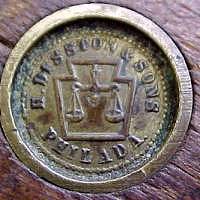
|
Before 1876. The lettering on this medallion has serifs, unlike those before or after its production. This medallion is like the others shown above in that it is the split-nut design and is filed flush with the surface of the handle. After the mid-1870's, the domed-style nut came into use. | |
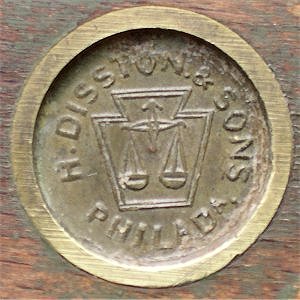
|
This medallion has its perimeter flush with the handle's surface, like all that precede it, but the lettering and design of the keystone and scale are identical to the unique "Choice" saw medallion shown below. This dates the medallion close to 1874-75. The split-nut or spanner style of fastner is about to be phased out. Hey, the "A" at the end of "PHILADA" got small again. | |

|
This medallion is on a mid-1870's "Choice" saw, which was introduced about 1875. The perimeter is serrated, which is unique. It is raised above the surface of the handle, the first time that feature is seen. The saw has five split nuts on the handle, which also is unique to this model. | |
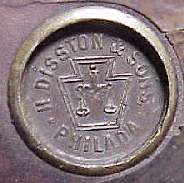
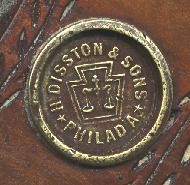
|
1880's. Larger letter "A" at the end of word "Philad'a". One has comma after the word "sons", the other doesn't. Instead of sitting completely flush with the handle like earlier medallions, there is a slight radius to the perimeter of the medallion, which rises above the wood. | |
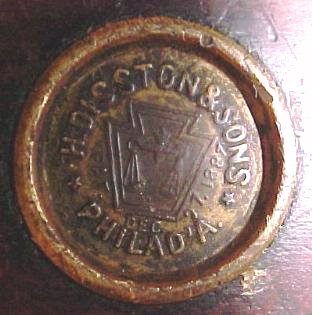
|
1888-early 1890's. Patent date for Glover's design of saw nuts, which are stronger than those manufactured in the 1870's and early 1880's. For an interesting anomaly in this medallion click here. | |

|
Same time period, just with the "27" moved under the keystone. | |

|
Another variation. | |
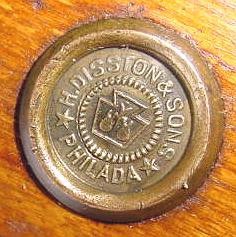
|
1896-1917 | |

|
1917-1942 (Between the wars) | |

|
1942-53 -- Some WWII saws have steel medallions. Note the shape of the perimeter of the medallion, as seen from the side, shown below.
|
|
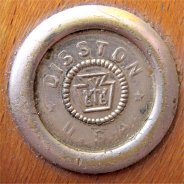
|
Saws from the late 1940's and early 1950's had this medallion with sloppy execution. Its perimeter is wide. D-8's and D-12's were nickel-plated; D-7's were the same style, but not plated.
|
|
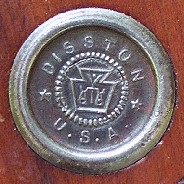
|
1953-55 -- Smaller diameter and a sloppy stamp. Note the shape of the perimeter of the medallion, as seen from the side, shown below.
|
|

|
||